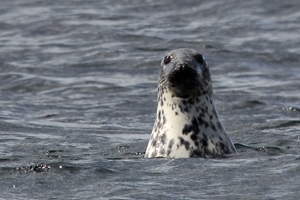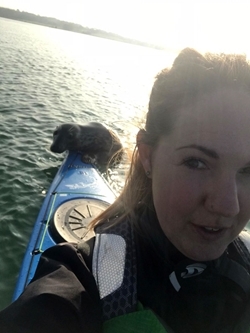Grey seal
 When we think of British mammals, most of us conjure up images of furry terrestrial animals – foxes, deer, mice, rabbits. But there are mammals in our seas too – and amongst the marine members of this class is an athletic, characterful carnivore: the grey seal (Halichoerus grypus).
When we think of British mammals, most of us conjure up images of furry terrestrial animals – foxes, deer, mice, rabbits. But there are mammals in our seas too – and amongst the marine members of this class is an athletic, characterful carnivore: the grey seal (Halichoerus grypus).
The grey seal is one of two seal species native to Great Britain and Ireland, the other being the harbour seal, which is slightly smaller, with a shorter face, and less common. They are pinnipeds, which means ‘fin feet’, and this group diverged from other mammals about 50 million years ago. I was surprised to learn that their closest relatives are bears and mustelids. Mainly because if I clamp my hands over my Labrador’s ears and pull back gently, he looks like a seal, so I thought they’d be closer to canines!
When describing a grey seal, you can do worse than simply translating their scientific name, which means ‘hook-nosed sea pig’. Bulls can weigh up to 310kg and are dark in colouration with splotches of lighter grey and brown. Cows are slightly smaller with dark spots on a lighter base colour. In both cases the markings are unique to each animal, and they have kindly faces thanks to their large snout, big dark eyes and thick curved whiskers. Up to half of the mass of a seal is blubber, which helps them stay warm and keeps them buoyant so they don’t waste energy on the surface.
Grey seals occur on both sides of the Atlantic, with colonies established on many temperate coasts in Canada, the USA and Western Europe. Britain alone has 40% of the world’s grey seals and this is part of the reason they are protected here. The other reason is because their population was very depleted in the past by ancestors across their range who hunted them for oil, skins and meat. They were also sought after by circuses and private owners for their ability to be trained to perform party tricks. Many people think that captive seals only clap because they’ve been taught to – but recent studies show that wild seals use clapping to communicate with each other and fend off predators!
A grey seal needs on average 5kg of food a day, and the main quarry around our coasts include cod, flatfish, wrasse, sand eels and crustaceans – but they are not fussy and will eat most things they can catch. They do not have foraging territories, but they do get possessive over mates and can have vicious fights to compete for harems of cows in a given area. Bulls quite often have visible scars from fighting, so a gnarly neck is another good way to tell the sexes apart!
Right now, grey seals are in the middle of the birthing season, whereby cows come ashore to have their single pup on land. The majority of births occur between November and February. A newborn grey seal pup weighs about the same as an adult cocker spaniel, and has a thick white coat. Mothers stay onshore and go without food until the pup is weaned, and thankfully this doesn’t take long because her milk is incredibly rich, with 50% fat. Once they’ve developed a thick blubber layer and shed their white coat, they are ready to join the other seals in the sea and learn how to hunt for themselves.
Thankfully, due to their large size and athleticism underwater, they have few predators here in Britain, but in the far north of Scotland some will fall prey to the resident killer whales. Boat strike is not uncommon, given their easy-going attitude around populated beaches. With white-tailed eagles on the ascendancy once more in the south of England, it will be interesting to see if seal pups appear on their menu!
 Grey seals can slink around unnoticed on quieter coasts, but in more populated areas they can be very inquisitive and curious, often swimming alongside boats and other watersports craft. The day after I started writing this blog, my friend Jenny from the Isle of Wight had an incredible encounter with a grey seal whilst kayaking (see photo). She was in equal parts amused and terrified when a grey seal climbed aboard and posed for the camera. I don’t think she was expecting to go home with a ‘seal-fie’ that day!
Grey seals can slink around unnoticed on quieter coasts, but in more populated areas they can be very inquisitive and curious, often swimming alongside boats and other watersports craft. The day after I started writing this blog, my friend Jenny from the Isle of Wight had an incredible encounter with a grey seal whilst kayaking (see photo). She was in equal parts amused and terrified when a grey seal climbed aboard and posed for the camera. I don’t think she was expecting to go home with a ‘seal-fie’ that day!
Jess Brooks
Advisory
Photo credit: Dunpharlain